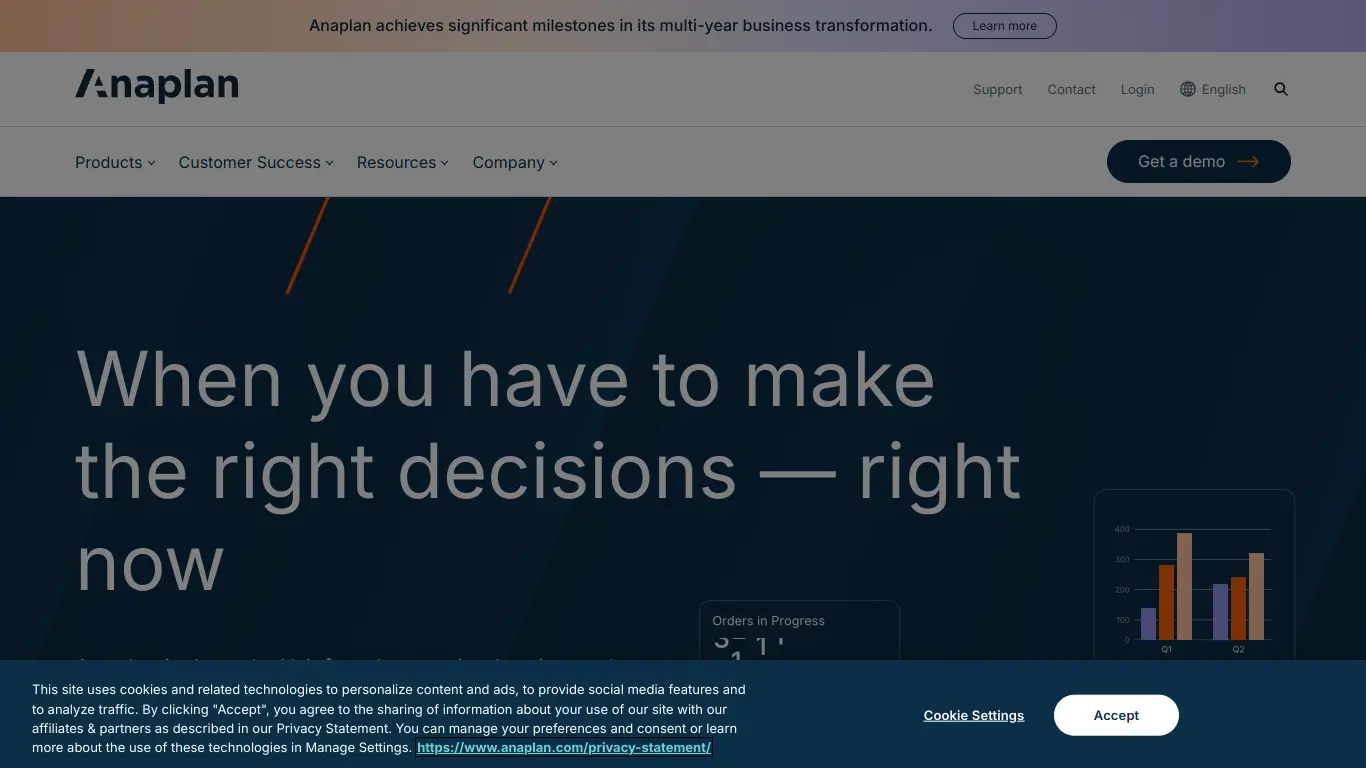Anaplan is a connected planning platform that helps enterprises make better decisions by unifying financial, operational, and strategic planning.
Introduction to Anaplan
Making informed decisions quickly can mean the difference between success and failure. If you’re struggling with disconnected planning processes, siloed data, or the inability to pivot your business strategy in real-time, you’re not alone. Many businesses find themselves hampered by outdated planning tools that can’t keep pace with market changes. This is where Anaplan steps in – a revolutionary platform designed to transform how businesses plan, analyze, and execute.
What is Anaplan and its Purpose?
Anaplan is a cloud-based business planning and performance management platform that enables organizations to accelerate decision-making by connecting data, people, and plans across the business. Unlike traditional planning tools that focus on individual departments, Anaplan provides a unified, real-time view of the entire organization.
At its core, Anaplan serves as a Connected Planning platform that breaks down silos between finance, supply chain, sales, HR, and other departments. The platform combines sophisticated modeling capabilities, collaboration features, and flexible deployment options to help businesses make better decisions faster.
What makes Anaplan stand out is its proprietary Hyperblock™ technology, which allows for complex calculations across massive data sets while maintaining speed and performance. This technology enables organizations to create detailed, interconnected models that automatically update when changes occur anywhere in the system.
Who is Anaplan Designed For?
Anaplan caters to a diverse range of users across various industries and departments:
By Industry:
- Financial Services
- Consumer Products
- Technology
- Manufacturing
- Healthcare
- Retail
- Professional Services
By Department:
- Finance and Accounting
- Sales
- Supply Chain
- Marketing
- Human Resources
- IT
The platform is particularly valuable for:
- Enterprise organizations looking to unify planning across multiple departments and regions
- Mid-market companies seeking to replace disconnected spreadsheets with a more robust solution
- Business leaders who need to make data-driven decisions quickly
- Finance professionals requiring sophisticated modeling capabilities
- Operations teams wanting to optimize supply chains and resource allocation
- Sales leaders looking to improve territory planning and quota management
From C-suite executives to departmental managers and individual contributors, Anaplan provides tailored experiences that meet the specific needs of various stakeholders within an organization.
Getting Started with Anaplan: How to Use It
Starting your journey with Anaplan involves several key steps:
- Needs Assessment: Begin by identifying the specific planning challenges your organization faces. Anaplan works with you to understand your business objectives and design a tailored solution.
- Implementation: Anaplan offers several implementation approaches:
- Work with Anaplan’s professional services team
- Partner with one of Anaplan’s certified implementation partners
- Use internal resources if you have Anaplan expertise in-house
- Model Building: Create your planning models using Anaplan’s intuitive modeling capabilities. You can start with pre-built applications from the App Hub or build custom models from scratch.
- Data Integration: Connect Anaplan to your existing data sources, including ERP systems, CRM platforms, HR systems, and more.
- User Training: Train your team members using Anaplan’s comprehensive learning resources, including Anaplan Academy, which offers both self-paced and instructor-led training options.
- Deployment and Adoption: Roll out the solution to your user base, focusing on change management and adoption strategies to ensure success.
- Continuous Improvement: Regularly refine your models and processes based on feedback and changing business needs.
Anaplan’s interface is designed to be user-friendly, with a familiar spreadsheet-like experience that makes it accessible to business users without requiring extensive technical knowledge. The platform provides both web and mobile access, allowing users to stay connected and make decisions on the go.
Anaplan’s Key Features and Benefits
Core Functionalities of Anaplan
Anaplan’s platform is built around several core functionalities that work together to deliver a comprehensive planning solution:
1. Modeling Engine
Anaplan’s patented Hyperblock™ technology powers its modeling capabilities, enabling:
- Real-time calculations across large, complex data sets
- Multi-dimensional modeling that connects data from various sources
- “What-if” scenario planning to test different assumptions
- Time-based modeling (weeks, months, quarters, years)
2. Collaboration Features
- Role-based access controls ensure users see only what they need
- Real-time updates visible to all stakeholders
- Commenting and annotation capabilities
- Workflow management for approvals and reviews
3. Data Integration
- API-based connections to external systems
- Pre-built connectors for popular enterprise applications
- Bulk data import/export capabilities
- ETL (Extract, Transform, Load) processes
4. Reporting and Analytics
- Customizable dashboards and visualizations
- Drill-down capabilities for detailed analysis
- Exportable reports in multiple formats
- Mobile-friendly visualizations
5. App Hub
- Pre-built applications for common use cases
- Industry-specific solutions
- Department-specific templates
- Ability to customize apps for specific needs
6. Security and Compliance
- SOC 1, SOC 2, and ISO 27001 certifications
- Data encryption at rest and in transit
- Role-based security model
- Audit trails for all changes
Advantages of Using Anaplan
Organizations that implement Anaplan typically experience numerous benefits:
🚀 Speed and Agility
- 50-90% reduction in planning cycle times
- Ability to reforecast quickly when conditions change
- Faster decision-making through real-time insights
🔄 Connected Planning
- Elimination of departmental silos
- Consistent data across the organization
- Better alignment between strategy and execution
💰 Financial Impact
- Average 10-30% improvement in forecast accuracy
- Reduced labor costs through automation
- Better resource allocation
- Improved cash flow management
🛠️ Operational Efficiency
- Elimination of error-prone manual processes
- Reduced time spent on data collection and reconciliation
- More time for value-added analysis
📊 Better Decision-Making
- Data-driven insights rather than gut feelings
- Ability to model complex scenarios
- Clearer understanding of cause-and-effect relationships
☁️ Cloud-Based Advantages
- No hardware infrastructure required
- Automatic updates and enhancements
- Scalability to grow with your business
- Accessibility from anywhere
Main Use Cases and Applications
Anaplan’s flexibility allows it to address a wide range of planning challenges across departments:
Finance
- Financial Planning and Analysis (FP&A)
- Budgeting and forecasting
- Rolling forecasts
- Profitability analysis
- Capital planning
- Tax planning
Sales
- Territory and quota planning
- Incentive compensation management
- Account segmentation
- Pipeline analysis
- Sales forecasting
Supply Chain
- Demand planning
- Supply planning
- Inventory optimization
- S&OP (Sales and Operations Planning)
- Logistics planning
Workforce
- Headcount planning
- Talent management
- Succession planning
- Compensation planning
- Workforce optimization
Marketing
- Marketing resource allocation
- Campaign planning
- Marketing mix optimization
- Trade promotion management
IT
- Project portfolio planning
- Resource allocation
- Technology investment planning
- IT cost modeling
Each of these applications can be implemented individually or as part of a connected ecosystem, allowing organizations to start with their most pressing needs and expand over time.
Exploring Anaplan’s Platform and Interface
User Interface and User Experience
Anaplan’s interface strikes a balance between power and accessibility, providing robust capabilities without overwhelming users.
Dashboard Layout
The platform typically presents users with:
- A navigation panel for accessing different models and applications
- A central workspace for viewing and editing data
- Dashboard panels displaying key metrics and visualizations
- Action buttons for common tasks and functions
Data Input and Manipulation
- Grid-based layouts familiar to spreadsheet users
- Drag-and-drop functionality for building models
- Color-coding and conditional formatting
- In-cell formulas and functions
- Time-saving keyboard shortcuts
Visualization Capabilities
Anaplan offers a variety of visualization options to make data more digestible:
- Bar and line charts
- Pie and donut charts
- Waterfall diagrams
- Heat maps
- Scatter plots
- Bubble charts
- Gantt charts
Customization Options
Users can personalize their experience through:
- Custom dashboard layouts
- Saved views and filters
- Personal bookmarks
- Color schemes and branding options
Learning Curve
While Anaplan is designed to be user-friendly, there is still a learning curve, particularly for advanced modeling capabilities. However, most users report that:
- Basic navigation feels intuitive within hours
- Basic modeling skills develop within days
- Proficiency with advanced features takes a few weeks
- True mastery develops over months of regular use
Anaplan’s user experience is continuously evolving, with regular updates introducing new features and refinements based on user feedback.
Platform Accessibility
Anaplan prioritizes accessibility to ensure users can access their planning data whenever and wherever needed.
Device Compatibility
- Desktop access via web browsers (Chrome, Firefox, Safari, Edge)
- Mobile access via dedicated iOS and Android apps
- Tablet-optimized interface
- Responsive design that adapts to different screen sizes
Global Availability
- Cloud infrastructure in multiple regions for performance and compliance
- Support for multiple languages
- 24/7 system availability with minimal planned downtime
Performance Considerations
- Fast calculation speeds even with large data sets
- Performance optimizations for slower internet connections
- Offline capabilities for certain functions
Accessibility Features
- Keyboard navigation support
- Screen reader compatibility
- Color contrast options
- Text size adjustments
Anaplan continues to invest in making its platform more accessible and user-friendly across all devices and user scenarios.
Anaplan Pricing and Plans
Subscription Options
Anaplan follows an enterprise SaaS (Software as a Service) pricing model with several tiers designed to meet different organizational needs.
While Anaplan doesn’t publish specific pricing on their website, their subscription model is generally structured as follows:
| Plan Level | Typical Organization Size | Key Features | Approximate Price Range |
|---|---|---|---|
| Standard | Mid-market companies | Core planning capabilities, limited model complexity | $20K-$75K annually |
| Enterprise | Large organizations | Advanced modeling, multiple use cases, enhanced security | $75K-$200K+ annually |
| Global Enterprise | Multinational corporations | Global deployment, highest security tier, priority support | $200K-$1M+ annually |
Pricing is typically based on several factors:
- Number of users
- Data volume
- Model complexity
- Required computing resources
- Implementation services
- Training needs
Anaplan typically works with customers to create customized packages based on their specific requirements and use cases. This consultative approach ensures organizations get the capabilities they need without paying for unnecessary features.
Most subscriptions include:
- Cloud hosting and infrastructure
- Regular platform updates
- Standard support
- Basic training resources
Additional services available for purchase include:
- Premium support options
- Advanced training programs
- Expert consulting services
- Dedicated success management
Free vs. Paid Features
Unlike many SaaS platforms, Anaplan doesn’t offer a permanent free tier or freemium model. However, they do provide several options for organizations to explore the platform before making a full commitment:
Evaluation Options
- Personalized demos tailored to your industry and use cases
- Proof of concept projects for specific business challenges
- Limited-time trial environments for hands-on exploration
Free Resources
While the platform itself requires a subscription, Anaplan offers numerous free resources to help organizations understand the potential value:
- Webinars and virtual events
- Case studies and white papers
- Basic training through Anaplan Academy
- Community forums for knowledge sharing
Paid Extensions
Beyond the core subscription, organizations can enhance their Anaplan implementation with additional paid features:
- Advanced integrations with enterprise systems
- Premium connectors for specific applications
- Additional computing capacity for complex models
- Dedicated environments for development and testing
For organizations considering Anaplan, the best approach is to contact their sales team directly for a customized quote based on your specific needs and use cases.
Anaplan Reviews and User Feedback
Pros and Cons of Anaplan
Based on analysis of user reviews across multiple platforms, here’s a balanced assessment of Anaplan’s strengths and weaknesses:
Pros:
✅ Powerful Modeling Capabilities
Users consistently praise Anaplan’s ability to handle complex, multi-dimensional models with large data sets. The platform’s calculation engine allows for sophisticated planning scenarios that would be impossible in spreadsheets.
✅ Real-Time Collaboration
The ability for multiple users to work simultaneously with immediate visibility into changes is frequently cited as a major advantage over traditional planning tools.
✅ Flexibility and Adaptability
Organizations appreciate how Anaplan can be configured to match their specific business processes rather than forcing them to adapt to rigid, pre-defined workflows.
✅ Integration Capabilities
The platform’s ability to connect with various data sources and enterprise systems enables truly connected planning across the organization.
✅ Visualization and Reporting
Users value the intuitive dashboards and visualization capabilities that make complex data easier to understand and act upon.
Cons:
❌ Learning Curve
Many users report that achieving proficiency with Anaplan’s more advanced features requires significant time and training. The platform is powerful but can be complex for new users.
❌ Implementation Complexity
Organizations sometimes struggle with initial implementation, particularly when attempting to connect multiple use cases or integrate with legacy systems.
❌ Cost
Anaplan’s pricing is frequently mentioned as a potential barrier, especially for smaller organizations or those with limited planning needs.
❌ Mobile Experience
While Anaplan offers mobile apps, some users report that the mobile experience isn’t as robust as the desktop version.
❌ Formula Syntax
Some users coming from Excel find Anaplan’s formula language requires adjustment, though most eventually prefer it once they become familiar.
User Testimonials and Opinions
Here’s what actual Anaplan users have to say about their experiences:
“Anaplan has transformed our financial planning process. What used to take us weeks now happens in days, and the quality of our forecasts has improved dramatically. The connected planning approach means our sales and operations teams are finally working from the same playbook.”
— Financial Planning Director, Retail Industry
“The implementation was more complex than we initially expected, but the results have been worth it. We’ve reduced our planning cycle by 60% and now spend more time on analysis instead of data collection and reconciliation.”
— VP of Supply Chain, Manufacturing Company
“Anaplan’s flexibility is both its greatest strength and challenge. You can build almost anything, but that means you need to think carefully about design and best practices. We made some mistakes early on but have learned to create more sustainable models over time.”
— Business Systems Analyst, Technology Company
According to G2 and other review platforms, Anaplan consistently scores well in:
- Calculation capabilities
- Scenario planning
- Enterprise scalability
- Performance with large data sets
Areas where users sometimes request improvements include:
- Simpler model building for business users
- Enhanced data visualization options
- More intuitive user interface for occasional users
- Better documentation and training resources
Overall, Anaplan tends to receive the highest satisfaction ratings from enterprise organizations with complex planning needs across multiple departments, while smaller organizations sometimes find the platform more powerful than necessary for their requirements.
Anaplan Company and Background Information
About the Company Behind Anaplan
Anaplan was founded in 2006 by Guy Haddleton and Michael Gould in a barn in Yorkshire, England. The company’s name derives from “analytics” and “planning,” reflecting its core mission to revolutionize how businesses plan and make decisions.
Company Timeline:
- 2006: Founded in the UK
- 2010: Headquarters moved to San Francisco, California
- 2012: Raised Series C funding of $33 million
- 2014: Reached $100 million in annual recurring revenue
- 2018: Completed IPO on the New York Stock Exchange (NYSE: PLAN)
- 2022: Acquired by Thoma Bravo (private equity firm) for $10.7 billion
Leadership:
Anaplan is led by a team of experienced executives with backgrounds in enterprise software, cloud computing, and business transformation. The current CEO is Charles Sciales, who joined the company after the acquisition by Thoma Bravo.
Global Presence:
Today, Anaplan operates worldwide with:
- 20+ office locations across North America, Europe, Asia, and Australia
- 1,900+ employees globally
- 175+ partners in its ecosystem
- Customers in 50+ countries
Company Culture:
Anaplan prides itself on a culture centered around innovation, customer success, and collaboration. The company consistently ranks as a top workplace and emphasizes diversity and inclusion initiatives.
Market Position:
Anaplan is recognized as a leader in the Connected Planning space and competes in several enterprise software categories:
- Enterprise Performance Management (EPM)
- Corporate Performance Management (CPM)
- Sales Performance Management (SPM)
- Supply Chain Planning
- Workforce Planning
Industry Recognition:
The company has received numerous accolades, including:
- Leader in Gartner Magic Quadrant for Financial Planning Software
- Leader in Forrester Wave for Enterprise Performance Management
- Various innovation and growth awards from industry publications
Customer Base:
Anaplan serves over 1,900 customers worldwide, including:
- More than 175 of the Fortune 500 companies
- Organizations across 20+ industry verticals
- Both global enterprises and mid-market companies
The company’s transition from public company to private equity ownership under Thoma Bravo in 2022 has allowed it to focus on long-term platform development and customer success initiatives without the quarterly pressures of the public markets.
Anaplan Alternatives and Competitors
Top Anaplan Alternatives in the Market
If you’re evaluating planning solutions, it’s worth considering these top alternatives to Anaplan:
1. Oracle Cloud EPM
Oracle Cloud EPM
- Strengths: Deep financial planning capabilities, strong integration with Oracle ERP, extensive reporting
- Best for: Oracle-centric organizations, finance-focused planning
- Pricing: Enterprise-level pricing, typically higher than Anaplan
2. SAP Analytics Cloud
SAP Analytics Cloud
- Strengths: Tight integration with SAP ERP, combined planning and BI capabilities
- Best for: SAP customers, organizations seeking combined planning and analytics
- Pricing: Subscription-based, often bundled with other SAP products
3. Workday Adaptive Planning
Workday Adaptive Planning
- Strengths: User-friendly interface, strong financial planning, HR integration
- Best for: Mid-market companies, Workday HCM/Financials customers
- Pricing: Lower entry point than Anaplan, scalable pricing
4. Board
Board
- Strengths: Combined planning, BI, and predictive analytics, flexible platform
- Best for: Organizations seeking integrated planning and analytics
- Pricing: Mid-range enterprise pricing
5. Planful (formerly Host Analytics)
Planful
- Strengths: Strong financial planning capabilities, user-friendly interface
- Best for: Finance-focused planning, mid-market companies
- Pricing: Lower entry point than Anaplan
6. IBM Planning Analytics (TM1)
IBM Planning Analytics
- Strengths: Powerful OLAP engine, extensive calculation capabilities
- Best for: Complex analytical requirements, IBM customers
- Pricing: Enterprise-level pricing, comparable to Anaplan
7. Jedox
Jedox
- Strengths: Excel-like interface, flexible deployment options
- Best for: Excel-centric organizations, mid-market companies
- Pricing: More affordable than Anaplan for smaller deployments
8. Pigment
Pigment
- Strengths: Modern interface, collaborative features, visual approach
- Best for: Growing companies, visual planners
- Pricing: Competitive with Anaplan for smaller deployments
Anaplan vs. Competitors: A Comparative Analysis
To help you understand how Anaplan stacks up against its main competitors, here’s a comparative analysis across key dimensions:
| Feature/Aspect | Anaplan | Oracle Cloud EPM | Workday Adaptive | SAP Analytics Cloud |
|---|---|---|---|---|
| Modeling Power | ★★★★★ | ★★★★☆ | ★★★☆☆ | ★★★★☆ |
| Ease of Use | ★★★☆☆ | ★★☆☆☆ | ★★★★★ | ★★★☆☆ |
| Implementation Time | 2-6 months | 3-9 months | 1-3 months | 3-9 months |
| Integration Capabilities | ★★★★☆ | ★★★★★ (Oracle) | ★★★★★ (Workday) | ★★★★★ (SAP) |
| Cross-Functional Planning | ★★★★★ | ★★★☆☆ | ★★★☆☆ | ★★★★☆ |
| Financial Planning Depth | ★★★★☆ | ★★★★★ | ★★★★☆ | ★★★★☆ |
| Sales Planning Capabilities | ★★★★★ | ★★★☆☆ | ★★★☆☆ | ★★★☆☆ |
| Supply Chain Planning | ★★★★☆ | ★★★☆☆ | ★★☆☆☆ | ★★★★☆ |
| Workforce Planning | ★★★★☆ | ★★★☆☆ | ★★★★★ | ★★★☆☆ |
| Scalability | ★★★★★ | ★★★★★ | ★★★☆☆ | ★★★★☆ |
| Cost | $$$$ | $$$$$ | $$$ | $$$$ |
| Cloud Maturity | ★★★★★ | ★★★★☆ | ★★★★★ | ★★★★☆ |
When Anaplan Stands Out:
- For organizations seeking to connect planning across multiple departments
- When modeling complex, interconnected business processes
- For enterprises with sophisticated scenario planning needs
- When real-time collaboration across departments is essential
When Alternatives Might Be Better:
- Oracle EPM: For Oracle ERP customers with primarily financial planning needs
- Workday Adaptive: For smaller companies or those needing rapid implementation
- SAP Analytics Cloud: For SAP-centric organizations wanting combined BI and planning
- Board: For companies seeking integrated BI and planning in one platform
- Planful: For finance-focused planning with a lower price point
Your optimal choice depends on your specific business requirements, existing technology ecosystem, budget constraints, and timeline needs. Many organizations evaluate 2-3 options through detailed demonstrations or proof-of-concept projects before making a final decision.
Anaplan Website Traffic and Analytics
Website Visit Over Time
Based on available data from web analytics tools, Anaplan’s website (anaplan.com) demonstrates consistent traffic patterns reflecting its position as an established enterprise software provider.
| Quarter | Estimated Monthly Visits | Year-over-Year Growth |
|---|---|---|
| Q1 2023 | 550,000 – 650,000 | +8% |
| Q2 2023 | 500,000 – 600,000 | +5% |
| Q3 2023 | 480,000 – 580,000 | +4% |
| Q4 2023 | 530,000 – 630,000 | +6% |
Traffic patterns typically show:
- Peaks during major product announcements and events
- Increased visits during Q4 and Q1 (budgeting seasons)
- Temporary spikes during webinars and virtual conferences
- Steady growth in blog and resource content visits
The traffic volume reflects Anaplan’s focus on enterprise customers rather than high-volume consumer marketing.
Geographical Distribution of Users
Anaplan’s website visitors come from around the world, with the following approximate distribution:
- North America: 45-50%
- Europe: 25-30%
- Asia-Pacific: 15-20%
- Rest of World: 5-10%
The strongest country representation comes from:
- United States (35-40%)
- United Kingdom (8-10%)
- France (5-7%)
- Germany (5-7%)
- Australia (4-6%)
- India (3-5%)
- Canada (3-5%)
- Japan (2-4%)
This distribution aligns with Anaplan’s global office locations and target markets.
Main Traffic Sources
Anaplan’s website traffic comes from diverse sources, with the following approximate breakdown:
- Direct Traffic: 35-40%
- Organic Search: 25-30%
- Referral Traffic: 15-20%
- Paid Search: 10-15%
- Social Media: 5-8%
- Email Marketing: 3-5%
Top organic search keywords (non-branded) include:
- “connected planning”
- “enterprise planning software”
- “financial planning solutions”
- “sales planning tools”
- “supply chain planning platforms”
Major referral sources include:
- Business and technology news sites
- Industry analyst platforms (Gartner, Forrester)
- Partner websites
- Software review platforms
- Industry association websites
Social media traffic primarily comes from:
- LinkedIn (dominant source)
- YouTube
Anaplan’s traffic patterns demonstrate a focus on content marketing, thought leadership, and targeted enterprise marketing rather than mass-market approaches.
Frequently Asked Questions about Anaplan (FAQs)
General Questions about Anaplan
What is Anaplan and what does it do?
Anaplan is a cloud-based planning platform that enables organizations to connect data, people, and plans across finance, sales, supply chain, HR, and other departments. It provides a unified environment for forecasting, budgeting, scenario planning, and decision-making.
Is Anaplan suitable for small businesses?
Anaplan is primarily designed for mid-sized to large enterprises with complex planning needs. Small businesses typically find that Anaplan’s capabilities exceed their requirements and may prefer simpler, less expensive alternatives designed specifically for smaller organizations.
How long does it take to implement Anaplan?
Implementation timelines vary based on complexity, but typically range from 2-6 months for the initial use case. Many organizations start with a focused implementation in one area (like financial planning) and then expand to additional departments over time.
What industries does Anaplan serve?
Anaplan serves virtually all industries, with particularly strong presence in financial services, technology, manufacturing, consumer products, retail, healthcare, and professional services. The platform is adaptable to industry-specific requirements through custom models and pre-built applications.
Feature Specific Questions
How does Anaplan differ from traditional spreadsheets?
Unlike spreadsheets, Anaplan provides:
- Real-time collaboration for multiple users simultaneously
- Connected data across departments and processes
- Automated data integration with source systems
- Enterprise-grade security and access controls
- Scalability to handle billions of calculation cells
- Version control and audit trails
- Consistent business rules and calculations
Can Anaplan integrate with our existing systems?
Yes, Anaplan offers various integration options:
- Pre-built connectors for popular enterprise systems
- API-based integration for custom connections
- ETL tools for data movement
- Import/export capabilities for file-based integration
Common integrations include ERP systems, CRM platforms, HR systems, data warehouses, and BI tools.
Is Anaplan available on mobile devices?
Yes, Anaplan offers mobile applications for iOS and Android devices. The mobile apps allow users to view dashboards, participate in planning processes, and make decisions on the go. While the mobile apps don’t provide all the functionality of the desktop version, they cover the most common use cases for executives and managers.
What security features does Anaplan provide?
Anaplan includes comprehensive security features:
- SOC 1, SOC 2, and ISO 27001 certifications
- Role-based access controls
- Data encryption at rest and in transit
- Single sign-on (SSO) integration
- Multi-factor authentication
- Detailed audit trails
- Regular security assessments and penetration testing
Pricing and Subscription FAQs
How much does Anaplan cost?
Anaplan pricing is custom-quoted based on factors like user count, model complexity, data volume, and required support levels. Typical annual subscriptions range from $20,000 for smaller implementations to $1 million+ for large enterprise deployments. Contact Anaplan directly for a quote tailored to your specific needs.
Is there a free trial version of Anaplan?
Anaplan doesn’t offer a standard free trial, but they do provide demonstration environments and proof-of-concept projects for qualified prospects. These tailored evaluations allow organizations to test Anaplan with their own data and use cases.
What’s included in an Anaplan subscription?
Standard subscriptions typically include:
- Platform access for licensed users
- Cloud hosting and infrastructure
- Regular platform updates and enhancements
- Standard support package
- Basic training resources
- Community access
Premium services available at additional cost include:
- Enhanced support levels
- Advanced training programs
- Dedicated success managers
- Additional computing resources
- Development/testing environments
Support and Help FAQs
What training resources are available for Anaplan?
Anaplan offers multiple training options:
- Anaplan Academy (online learning platform)
- Certification programs for different user roles
- Instructor-led training sessions
- Custom training workshops
- Documentation and knowledge base
- Video tutorials
- Community forums
How does Anaplan provide customer support?
Support options include:
- Standard support (included with subscription)
- Premium support (additional cost)
- Global support coverage across time zones
- Online case submission
- Community forums
- Knowledge base
- Partner support networks
Can we build Anaplan models ourselves or do we need consultants?
Organizations have several options:
- Work with Anaplan’s professional services team
- Engage certified Anaplan partners for implementation
- Build internal capabilities through Anaplan’s training programs
Most customers use a combination approach, starting with expert help and gradually developing internal expertise for ongoing model management and expansion.
Conclusion: Is Anaplan Worth It?
Summary of Anaplan’s Strengths and Weaknesses
After a comprehensive review of Anaplan’s capabilities, market position, and user feedback, here’s a balanced assessment of its strengths and weaknesses:
Key Strengths:
- Powerful Connected Planning – Anaplan excels at breaking down silos between departments, creating a unified planning ecosystem that aligns finance, operations, sales, and HR.
- Flexible Modeling Capabilities – The platform’s Hyperblock technology enables sophisticated, multi-dimensional modeling that can handle complex business relationships and massive data sets.
- Scalability – Anaplan can grow with your organization, supporting everything from focused departmental use cases to enterprise-wide planning transformations.
- Collaboration – Real-time collaboration features allow multiple stakeholders to work simultaneously, improving planning efficiency and alignment.
- Platform Approach – Rather than offering fixed applications, Anaplan provides a flexible platform that can be customized to match your specific business processes.
Notable Limitations:
- Learning Curve – Mastering Anaplan’s advanced capabilities requires investment in training and skill development.
- Implementation Complexity – Successful implementations typically require careful planning, change management, and often expert assistance.
- Cost – Anaplan represents a significant investment compared to simpler planning tools, particularly for smaller organizations.
- Resource Requirements – Getting the most value from Anaplan requires ongoing attention to model optimization and governance.
- Overkill for Simple Needs – Organizations with straightforward planning requirements may find Anaplan’s power excessive for their needs.
Final Recommendation and Verdict
Anaplan is likely worth the investment for:
✅ Mid-sized to large enterprises with complex, cross-functional planning needs
✅ Organizations struggling with disconnected spreadsheets and manual planning processes
✅ Businesses experiencing rapid change that requires frequent reforecasting and scenario analysis
✅ Companies seeking to transform decision-making through data-driven insights
✅ Enterprises with multiple departments that need to align their planning activities
Anaplan may not be the best fit for:
❌ Small businesses with straightforward planning requirements
❌ Organizations seeking an out-of-the-box solution with minimal customization
❌ Companies with limited budget for software and implementation services
❌ Businesses looking for combined BI and planning in a single platform
❌ Organizations without resources to manage and maintain sophisticated models
The ultimate value of Anaplan comes from its ability to transform planning from a periodic, departmental exercise into a continuous, connected process that enhances decision-making across the organization. When implemented successfully with proper change management and user adoption, Anaplan can deliver significant returns through improved forecast accuracy, reduced planning cycle time, and better resource allocation.
Like any powerful enterprise platform, your success with Anaplan will depend not just on the technology itself, but on how well you implement it, how effectively you train your users, and how successfully you integrate it into your planning processes.
For organizations with the right use cases and commitment to implementation, Anaplan represents one of the most capable and mature planning platforms available today, with the potential to deliver substantial business value through connected, intelligent planning.





















